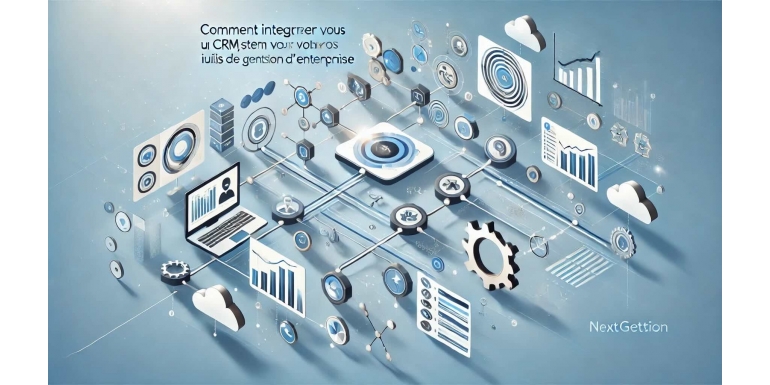
How to Integrate a CRM with Your Other Business Management Tools
Integrating a CRM (Customer Relationship Management) system with other business management tools is essential for optimizing processes, improving productivity, and maximizing customer satisfaction. An isolated CRM can limit the efficiency of your teams, while seamless integration with other systems enables more consistent data management, automated workflows, and better decision-making. This article explores how to integrate a CRM, particularly Dolibarr, with your other business management tools to maximize the benefits of your technological infrastructure.
1. Why CRM Integration is Crucial
Integrating a CRM with other business management tools, such as accounting systems, inventory management, or human resources management, offers several advantages:
- Data Centralization: When your systems are integrated, all customer, financial, and operational information is centralized, reducing errors and ensuring that all teams work with the same up-to-date data.
- Process Automation: Integration allows for the automation of many business processes, such as invoicing, order management, or report generation, freeing up time for your teams and improving overall efficiency.
- Better Customer Experience: With a unified view of customer data, your teams can offer a more personalized and responsive customer experience, increasing satisfaction and customer loyalty.
- Improved Decision-Making: Integrating your systems allows for the generation of consolidated reports, providing a clearer view of your business performance and facilitating strategic decision-making.
2. Introducing Dolibarr: A Flexible and Integrable CRM
Dolibarr is an open-source CRM that stands out for its flexibility and ability to easily integrate with other business management systems. Whether you use Dolibarr for customer relationship management, invoicing, or inventory management, this CRM can be connected to other tools to create a coherent and interconnected ecosystem.
- Modularity: Dolibarr is designed in modules, allowing businesses to choose and integrate only the functionalities they need. This modularity makes it easier to integrate with other software and systems already in place.
- Open Source: As an open-source software, Dolibarr offers great transparency and the ability to customize and extend functionalities according to the specific needs of the business. This includes integration with existing management tools or third-party solutions.
- Community and Support: Dolibarr has an active community that regularly develops plugins and extensions to facilitate integration with other systems, including accounting solutions, e-commerce platforms, and ERP systems.
3. Key Steps to Integrate Dolibarr with Your Other Management Tools
Here are the essential steps to integrate Dolibarr with your other business management tools:
a. Needs Assessment
Before starting the integration, it is important to assess your specific needs. Identify the business processes that would benefit most from integration, such as synchronizing customer data between the CRM and the accounting system, or integrating online orders with inventory management.
b. Selection of Modules and Plugins
Dolibarr offers a wide range of modules and plugins that can be used for integration. For example, Dolibarr’s invoicing module can be integrated with accounting systems like QuickBooks or Sage. Similarly, Dolibarr can be connected to e-commerce platforms to synchronize orders and customer data.
c. Using APIs
For more complex integrations, using APIs (Application Programming Interfaces) is often necessary. Dolibarr has a REST API that allows you to connect the CRM to other applications and facilitate real-time data exchange. For example, you can use Dolibarr’s API to integrate the CRM with an existing ERP system, ensuring continuous data synchronization.
d. Testing and Validation
After configuring the integration, it is crucial to conduct thorough testing to ensure that the systems are communicating correctly. This includes verifying data synchronization, the accuracy of generated reports, and the smoothness of automated processes.
e. User Training
Once the integration is in place, it is important to train your teams on using the integrated systems. Ensure that all users understand how to access new features, how data is shared between systems, and how to take advantage of automated processes.
4. Examples of Successful Integrations with Dolibarr
- Integration with an ERP: Dolibarr can be integrated with an ERP system for unified business process management. This allows for centralizing production, finance, and HR operations with customer management, improving overall business efficiency.
- Connection to Accounting Tools: By integrating Dolibarr with accounting software, businesses can automate invoicing, payment tracking, and customer account management, reducing errors and speeding up financial processes.
- Synchronization with E-Commerce Platforms: Dolibarr can be connected to platforms like WooCommerce or Prestashop, allowing for real-time synchronization of orders, customer data, and inventories, providing a comprehensive view of commercial operations.
Conclusion
Integrating a CRM with other business management tools is a powerful strategy to improve efficiency, centralize data, and automate business processes. Dolibarr, with its modularity, open-source architecture, and robust integration capabilities, is an ideal choice for businesses looking to create a coherent and effective technological ecosystem.
By following best integration practices, you can maximize the benefits of your CRM and ensure smooth and efficient management of your business. Whether it’s synchronizing customer data with accounting, automating inventory management, or centralizing operations, Dolibarr offers the flexibility and power needed to meet the evolving needs of your business.
